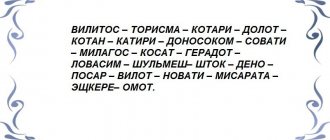Our ancestors used ancient conspiracies and spells in various situations. And their faith in magic words instantly activated the universal energy - their wishes came true.
Many sacred texts have been handed down to us. They can be found in old books. In modern magical practice, ancient spells are widely used in conjunction with rituals.
To experience the magic of spells, it is not enough just to say the necessary set of words. At this moment, you also need to imagine how the dream you are working on becomes a reality. The direction of thought is important when reading conspiracies.
Thanks to the centuries-old experience of our ancestors, we have a unique opportunity to improve and correct our mistakes. And the magic of ancient times will help with this.
Rules for reading conspiracies and spells
From the depths of antiquity, our generation was handed down a mandatory and unquestioning set of laws and rules regarding the correct reading of spell texts and prayers.
Anyone who wants to use the power of conspiracies should know them: both beginners and professionals. The main ones include the following:
- For the sacred text to be activated, you need to read it in good health. If you feel any discomfort (even a slight headache), the magic will not work and may even cause harm.
- The words in the conspiracy are pronounced as quietly as possible - ideally in a whisper. This condition is necessary to protect yourself from outside interference. If the text is heard by anyone else, it will not bring the desired result.
- The way the spell is written is how it should be used. Under no circumstances is it permitted to change its meaning, use synonyms or move words. The ancestors initially formulated a precise appeal to magical powers - and it is unquestioning.
- Carrying out a ritual is a rather energy-intensive activity; the magician must fully prepare himself. To do this, a few days before the ceremony, it is necessary to limit the consumption of junk food, give up alcoholic beverages and cigarettes. Let your body and soul be cleansed and gain strength.
- If you are performing a sacred act not for yourself, never demand payment for your work, otherwise the effect will be zero.
- On Tuesday, Wednesday and Saturday, conspiracies aimed at good are read, but those that have a negative message are read on Monday or Friday.
- A magician must have strong and healthy teeth. This is extremely important for performance.
- And the most important condition is faith in your deeds. Even the most powerful wizard is powerless when he lacks self-confidence.
We attract good earnings
To carry out an ancient and very effective ritual, it must be a new moon and a Friday. With its help, you can find a good job with high pay.
In the evening you will have to visit the forest or the nearest forest belt. There should be no strangers. Walk without looking back. Find a place in advance with two stumps, and sit on one of them. Tune in and read a strong plot:
You need to go into the forest in the evening, walk without turning around, find a place with two tree stumps, sit on one and read a strong spell
Return home and wait for your wish to come true. In a few days you should receive a job offer with a good salary.
Ancient magic spells - love spell
There are a lot of conspiracies that affect the love side of life. But the question of choosing the most effective one is not an easy one. Usually the spell text brings the desired, but the effect does not last long, since it can be easily removed by another magician.
The method described here will create a real miracle and bind your loved one to you forever. All you need is an ordinary candle - and nothing more.
But even in the old days, magicians and witches warned that you should not cast magic on a person who is already bound by obligations and has his own family. By destroying the happiness of others, you bring disaster upon yourself. All demons and evil spirits will turn against you.
Wait until the waxing moon begins. At night (about two o'clock) lock all the doors in the house - make sure that there are no drafts everywhere.
Make sure there is no one else in the room. But since this is not easy to achieve, just stay in the room alone so that no one can see or hear you.
Light a candle and start peering into the flame. Carefully examine the flame, imagine its warmth.
Now visualize your desire: you are together with your loved one. Your happiness is limitless. You are pleased to be near him, to feel his warmth. The feelings are mutual and very strong.
Gradually you will understand that your heart is filled with love - the time has come for a conspiracy:
Believe me, your significant other will take the first steps towards starting a relationship in just a couple of days.
Ancient spells to attract wealth
It’s not just now that the question of wealth worries many families. In all centuries, peoples have tried to attract wealth in various ways. And magic was not the last place in this matter. Ancient works contain a huge selection of rituals that work with monetary energy.
Important: prepare thoroughly before performing magical actions. First, a person must cleanse the body. To do this, you should not drink alcohol, and also give up fatty foods and sweets. Your body should be light and your mind should be freed from unnecessary thoughts.
Also, in the room where everything will take place, do a thorough cleaning. Dust and dirt attract negativity and evil spirits.
Immediately before the ritual, wash your body and head. This will give you energy and wash away the harmful energy accumulated during the day.
Required attributes:
- green church candle;
- dried cloves;
- long green thread;
- white fabric trim;
- matches or lighter.
Lay a white cloth on the table. Place the candle on top and light its wick. Advice from experts: from the first moments, imagine how you are starting to get rich - there is more and more money.
Tie 9 pieces of cloves with thread. And at this moment say:
Now you should surround your ritual candle with thread. Perform a magical ritual for nine days. And not a word to anyone about magic!
Peas are a leguminous plant used in ritual and magical practice (mainly among the Western and Eastern Slavs). Pea grains, pods and tops, as well as straw were used in various rituals. Peas are characterized by the semantics of fertility, productivity, and wealth, which unites it with other leguminous plants - beans, beans, lentils, characteristic of the rituals of Serbs, Macedonians and Bulgarians.
At the zap. For Slavs, Ukrainians and Belarusians, peas were the most important dish for Christmastide and especially for Christmas. The Czechs baked several grains of peas into ritual bread; the one who got them was expected to be happy in the coming year. Among the Poles of Silesia, it was necessary to eat at least a few grains of peas, “so that the chickens would not run away and rush into their yard,” and dishes made from cabbage with peas guaranteed a good harvest. In the villages of the Eastern Czech region. those who had horses on their farm ate a spoonful of peas on Christmas Eve, after which the worker galloped around the room with a bowl of peas to keep the horses frisky. Among the Slovaks, the owner threw a spoonful of peas into each corner and onto the ceiling with the words: “One hundred measures of peas, one hundred measures of poppy seeds, one hundred measures of wheat and one hundred measures of rye.” If at the same time a lot of peas stuck to the wall, this foreshadowed a fruitful year, and vice versa. Among the Belarusians of the Vilna province. On Christmas Eve, the owner sprinkled the beehives and garden with the peas left over from dinner to ensure fertility and harvest. To get a large harvest of peas, in Lusatia on Christmas night they rolled on unhusked peas, and the peas that fell from the pods were added to the seed grain. On St. Stefan Poles of Silesia and Poznań Voivs. they threw peas at the priest in the church, and then the grains were collected and sown in the spring. To the center. In Poland (Ostroleki district) on Christmas Day, during the service, peas were poured onto the parishioners from the choirs to ensure a good harvest, and in Silesia (on the second day of Christmas) - to make people happy. At Christmas dinner, Lusatians threw a spoonful of uncooked peas into the corner of the table so that the family would have money all year round. Slovenes on the river The Drave believed that if you bury peas in the ground on Christmas Eve where water flows from the roof, the devil will bring money. Among the Belarusians of the Vilna province. On Epiphany, the owner entered the hut with a basket of peas and addressed the family with a greeting in which peas were compared to gold, sprinkled peas on the table, and those sitting tried to catch them. The one who caught the most peas was expected to have good luck in raising sheep. For the Czechs, at Christmas, a shepherd caroler scattered three handfuls of peas around the house: the first - so that there would be beautiful bay horses, the second - calves, the third - lambs. On New Year's Day, children went from house to house, congratulating the owners and sprinkling them with grains of peas, wheat, and rye. They presented carolers with peas, porridge, and flour (in Ukrainian, Polish).
When serving a pea dish for Christmas dinner, a ritual was performed to invite forest animals. So, to the east. In Poland, before dinner, the owner threw peas into the corners of the entryway, saying: “Wolf, wolf, come eat peas, so that you don’t come again this year,” see Invitation). On holidays dedicated to the bear (among the Belarusians of the Vitebsk region) - “kamaedzitsa” at the beginning of spring, among the Bulgarians - on St. Andrei (XI 30), - among other dishes, food was prepared from peas. On Christmas Eve, Christmas Day, and also on St. Lucii (Slovak), on the eve of Easter (Varm. Masur.), fed chickens with peas so that they would lay eggs well (Czech, Slovak, Polish). The Moravans believed that a chicken would lay as many eggs as it would eat peas on Christmas Eve. In the Czech Republic and Moravia, throughout Lent, a Lenten dish called pučalka was prepared from sprouted and fried peas; in Ghana, girls cooked it for boys, for which they received a reward. The preparation of the dish at gatherings was accompanied by various jokes: for example, they sent an inexperienced girl to the edge of the village to buy peas, and there they poured stones for her instead of peas. In the area of Český Brod, pots of peas were knocked on tree trunks so that there were as many fruits as there were peas in the pot. This dish was used in the ritual of symbolically drowning Death (or Madder). In the North Moravian region. the girls walked around the village and collected peas with the words: “Give us some peas for the “puchalka”, we will make Death.” After making the rounds, this dish was prepared and eaten in the house where the figurine of Death was made. In Poland it was often made from pea straw. Girls from the district of Yablonevo (Torun military) went from house to house with the doll Mazhana and sang that she eats peas during Lent (cf. Zhur). Among the Poles and Czechs on Advent, Christmastide, Shrovetide or the fifth week During Lent, participants in ritual rounds dressed themselves in pea straw: they were entwined with it from head to toe or belted with a rope made of it. Sometimes the Poles wore a “pea bear” wearing an inverted sheepskin coat. At the end of the round, the pea straw on the “bear” was set on fire (Velikopol.) or removed and placed under chickens and geese so that they would lay eggs better and sit on eggs (Czech, Moravian). Wed. also Russian pea jester, scarecrow or pea scarecrow “an empty man, an eccentric, a laughing stock,” “an ugly dressed person.” On some holidays it was forbidden to eat peas. It was believed that if you eat peas on Christmastide or Maslenitsa, then a person’s teeth will begin to ache (pol.), boils, abscesses (white, pol., Czech), and lice (ju.malopol.) will appear. Russians were forbidden to eat peas until St. Elijah's Day. Peas played a large role in rituals associated with marriage and procreation. Among the Poles, peas were the main wedding dish (during the wedding, the participants performed a dance with a bowl of peas in their hands). The Czechs sprinkled peas on the young woman and used the grains stuck in her dress to guess the number of future children. In a Russian wedding (Pskov) the newlyweds were whipped with pea whips when they entered the house after the wedding. In Polish and Sorbian lyrical songs, peas have erotic symbolism. Among the Czechs, peas represent a girl of marriageable age. The Polish pea straw wreath symbolized lost innocence. In Pokuttya (Ukrainian), at the end of the harvest, when various wreaths were brought to the owner, only a married woman could carry a pea wreath. For rejected gentlemen, such a wreath was hung from the door or cart. Floor. “she ate too many peas”, “got pregnant out of wedlock” (cf. also Kashub. “she ate too many peas”, “the peas bloat her”) corresponds to Russian. eat peas to “get pregnant”, Siberian. eat too many peas to “get pregnant” (about an unmarried woman). Wed. also kashub. climb into the pea straw “get pregnant.” There is a Slavic fairy tale about the birth of a hero named Pokatygoroshek (Russian) from pea grains, which were swallowed by the queen mother (Russian). Peas, beans or lentils were part of the ritual gift to the mother in labor and the newborn from the godmother at christening (Z. Slovak. Myjava). To make their children's hair curly, women ate stolen peas and buried the afterbirth in a pea bed (Karpatian Ukrainian). In funeral rituals, peas were intended for the dead. All in. In Slovakia, they scattered it in corners at Christmas or threw it behind the stove for the souls of the dead. In Upper Hron they said that the souls of the dead walk around crying in a house where this custom has been forgotten, because they are hungry. Among the Poles and Belarusians, peas, beans, and beans, steeply boiled in honey, served as ritual food on memorial days. During meals, windows and doors were opened, the eldest in the family walked around the house, looked towards the cemetery and called on the parents for a treat. Before the start of the meal, the first three spoons were poured into a special vessel for the dead (z.bel.). They also prepared “dry peas” without salt, the first spoon of which was set aside for the “grandfathers” (white). In the region of Rzeszow (pol.), on the day of remembrance of the dead, relatives distributed peas to the poor at the cemetery. To ease the agony, they placed peas or pea straw under the head of the dying person (yu.malopol.), and laid him on the ground on pea straw (Ukr.). Peas were used in magic. With the help of young peas placed in a cart or buried on the road, horses could be stopped (V. Slav., Pol.). While doing this, they said: “I’m throwing nine garakhvins!” The horses are in their places, / The horse is out of place” or “Get out of the garakhvinak! / The tenth anniversary, / Stand still, horses, without moving” (Gomel.). Throwing peas (from a pod with 12 grains) over the wedding train turned wedding participants into wolves (white). A person who ate peas on an empty stomach acquired the ability to put the evil eye on someone (gender). You can send a disease by burying a pot of peas under a wild pear tree during the waning moon: a person will have as many boils as there are peas in the pot (Czech). Peas, like some other plants (basil, beans, garlic, buckwheat), sprouted through the head (or body) of a snake killed in the spring, have miraculous powers. A flower of such a pea, collected at midnight or noon and placed in a wax ball in the mouth, helps to find out what is on everyone's mind (Russian); whoever eats the first pod of such peas will acquire the ability to understand the language of geese (Czech). To be invisible and inaudible while hunting, poachers on Thursday, Friday and Saturday of Holy Week put one pea into the eye holes and jaw of the snake, buried the skull, and covered it with a stone. A wreath was woven from the side shoots of grown peas and put under a hat, and peas that had sprouted through the jaws of a snake were placed in the mouth (Czech).
Peas could be used as a talisman. The cow was given a decoction of peas to protect it from spoilage (Krakow). The pea, which a man picked up from the ground and carried with him, protected him from evil (pol.). Peas from three fields, blessed on the Assumption, were used as a talisman against witches; peas eaten outdoors on Christmas Eve protected against the devil (Slovakian). Peas have been used in folk medicine. Peas were used mainly to get rid of skin diseases; warts, lichens, calluses, erysipelas were treated by touching the affected areas with a pea, after which it was thrown into the oven (Mazur.), into a well (Moravia), and the number of peas mattered (5, 7, 77 or as many as the warts) . It was believed that peas threshed at Christmas, stolen from three fields on a new moon, etc., were especially helpful. A decoction of three-year-old pea straw was used to treat tangles - based on the similarity of tangled hair and pea shoots (Minsk province). For toothache, it was recommended to take a mouthful of peas and spit the grains into a hole on the grave (Luzhitsa). Ukrainians of Poltava province. they represented Smallpox in the form of an old woman covered in peas, which she scattered everywhere to bring on the disease.
The pea field was considered the habitat of mythological characters: mermaids, kikimor (Russian, Belarusian), Baba Yaga (Russian), iron woman (Ukrainian). Children who picked peas were also frightened by such creatures as Zharenik (Russian), Baba Grokhova (pol.), Prepolnitsa (puddle). According to the ideas of the inhabitants of the Tatras, Podhale, Spiš, the merman and the divozhen ate peas and beans. Ukrainians-Rusyns, Belarusians of Grodno province. and the Lusatians believed that eels loved peas, especially their flowers, and came out of the river at night to fatten in the pea field. In Wielkopolska it was believed that witches hatched hail from peas, nuts, and eggs, which is why hailstones of different sizes are obtained.
A.A. Plotnikova, V.V. Usacheva
Ancient spells in Latin
When illness knocked a person down, in ancient times they used the power of ancient spells - and believed in them with all their souls. Some magical texts have also survived to this day.
The spells of the ancients in Latin were considered especially powerful. They not only restored health, but also provided immediate assistance. For example, the following conspiracy was used to stop bleeding:
If you translate it into our language, you get the following text:
Alena Golovina - white witch, master of Cosmoenergetics, author of the MAGiYA
Interesting on the topic:
- Ancient runic spells
- Spell to stop time
- Spells of Ancient Egypt
- Spell to gain magical power










